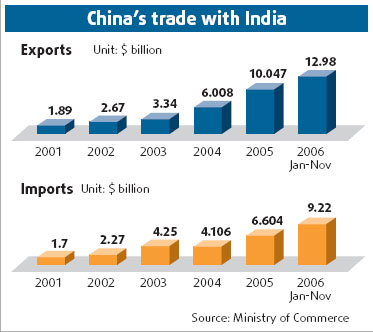China and India, whose economies are growing at a faster rate than any other in the world, have also been strengthening economic and trade relations with each other in recent years.
|

Habil Khorakiwala, president of the Federation of Indian Chambers of Commerce and Industry |
Looking ahead, they should pursue a closer partnership to advance bilateral trade and sustain their high economic growth rates as well, said Habil Khorakiwala, president of the Federation of Indian Chambers of Commerce and Industry (FICCI).
Nowadays, the rise of India and China is one of the most striking economic forces around the world, and makes Asia one of the world's most eye-catching regions. The two countries account for 40 percent of the global working age population and 18 percent of the world's economy on a purchasing power parity (PPP) basis.
"It will take just two more decades for our (China and India's) share of the global economic pie to match our share of global population," said Khorakiwala.
However, to live up to the predictions, "we need to sustain our current high growth rates and a large part of this growth will come through an outward-oriented strategy, like closer integration with the world economy, while partnering with each other," he added.
Rapid growth
China and India have seen more prosperous economic relations in the past decade.
Statistics show that trade between the two countries increased from $1.5 billion in 1998 to $2.3 billion in 2000, to $4.8 billion in 2002, and further to $7 billion in 2003.
The year 2004 saw the total trade surpassing the $10 billion mark and climbing up to more than $12 billion. The latest figures available from DGCI&S show that total trade between India and China in 2005 amounted to $17.6 billion.
With the average annual growth rate of China-India trade over the past 10 years being close to 35 percent, "the bilateral trade is expected to reach $30 billion by 2009," Khorakiwala said. 
Weak points
Despite the strong momentum in bilateral trade growth, the FICCI's president warned that the current trade pattern and composition is fraught with weaknesses.
"There has to be far greater exposure of mutual core competencies and opportunities available in each country," he suggested.
Diversifying bilateral trade should be the first priority. While China's exports to India are fairly diversified, ores, slag and ash account for more than 50 percent of India's exports to China.
Neither should mutual investment be ignored, as it shows a completely different picture from that of bilateral trade.
The foreign investment from Indian companies into China has covered industries as diverse as advertising and publicity, software development, drugs and pharmaceuticals, leather and leather products, auto components, building materials and sanitary fixtures. But investments from China into India are, according to Khorakiwala, still at a very "nascent" stage.
The key sectors where Chinese companies have invested in the Indian market include telecommunications, metallurgical industries, commercial, office and household equipment, the transportation industry and electrical equipment.
Chinese companies that have a presence in the Indian market include Sinosteel Corporation, Sany Heavy Industries Pvt Ltd, Yang Du Estate Pvt Ltd, Baosteel, ZTE Corporation, Zhejiang Topsun Group, Huawei Telecommunications Corporation and Haier Electrical Appliances Corporation.
Sinosteel India, formed in July 2005 in New Deli, has set up three branches within the resource-rich country, in Goa, Kolkata and Hospet. It has made considerable business progress since it was launched.
Mutual learning
There are many areas on which China and India could collaborate and gain from each other's experience and expertise, such as biotechnology, life sciences, specialty chemicals, IT, pharmaceuticals and space technology, especially leading-edge technology and services.
"Both India and China have centers of excellence in high technology that easily compare with the very best in the world. These areas of excellence should be at the core of future Sino-Indian collaboration," he said, naming the banking, healthcare, agriculture and energy sectors as offering a good scope for mutually beneficial partnership.
In the banking sector, exchanging and sharing experiences can help further financial sector reforms and improve services and operational efficiency in both countries.
"While India can offer its expertise in areas like supervision, payment systems and retail banking, China's strength in infrastructure financing can help India in tackling the issue of 'infrastructure deficit'," said Khorakiwala.
Healthcare is another area where China can immensely gain from India's experience, he said.
India's healthcare infrastructure has developed significantly over the last decade, and the country now boasts a number of state-of-the-art healthcare service facilities. India is a preferred destination for low-cost and high-end healthcare services for a number of people from the neighboring countries of Pakistan, Bangladesh and Sri Lanka.
"While China can make use of the Indian experience to set up and develop high-end healthcare facilities in its own country, India's private sector players can venture out to China and set up private hospitals and diagnostic facilities," he said.
In the agriculture sector, "both countries can benefit by sharing policy approaches and experiences, including building of a rural social security system, agricultural science and technology development, rural financing as well as pricing, marketing and distribution networks," Khorakiwala said.
"We should also share information on agri-biotechnology, cropping and farming practices, water management and soil conservation."
Issues need redressing
Indian businesses consider China as an important business partner.
"In many of our interactions with companies back home, one thing that has clearly emerged is that economic ties between India and China are strong, they are getting stronger, but they do not reflect the potential that exists," Khorakiwala said.
There are several FICCI studies that show the awareness level of Indian companies with regard to the operational business environment in China as just about average.
Many Indian companies are unfamiliar with the existing trade rules and regulations, with regard to their product categories, across various provinces in China.
Further, Indian exports to China face problems on account of a lack of information on customs procedures, complex standards and conformance norms, and expensive and time-consuming registration procedures.
"FICCI strongly feels that the two sides must set up a mechanism for redressing these issues," he said.
FICCI initiatives
FICCI has been actively working towards strengthening India-China bilateral commercial ties and have a Joint Business Council arrangement with China Council for the Promotion of International Trade since 1985, which provides a unique platform for business interface.
FICCI has also signed memorandums of understanding with several regional chambers and provinces to enhance trade and investment between the two countries
FICCI is also the initial founder member of China's annual economic gala Boao Forum for Asia and participates in the Boao Annual Conference every year.
FICCI was also able to contribute significantly to the India-China Joint Study Group being a member of the same.
In FICCI's endeavor to boost commercial relations between India and China and to cater to specific needs of its members, it has a registered office in Beijing, headed by Atul Dalakoti as executive director, who lived in China since the age of 12.






 RELATED
RELATED